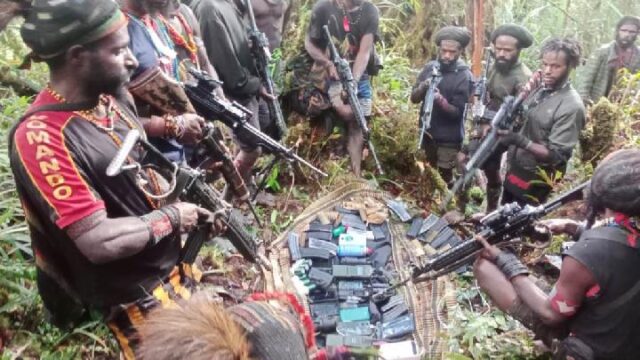
TPNPB Rebels Adopt New Tactics in Indonesia’s West Papua Province
Publication: Terrorism Monitor Volume: 21 Issue: 22
By:

On August 28, the West Papua National Liberation Army (TPNPB) killed a Papuan social worker, Michelle Kurisi Doga (suara.com, August 31). The group alleged that she was collecting data on Papuan refugees and mapping out TPNPB camps for Indonesia’s security forces in the restive territory of Nduga. The TPNPB also claimed that the group would kill all Papuans working with Indonesian security forces.
Nduga Regency has seen sustained violence since 2018. In recent months the regency has seen a high degree of activity by the Indonesian security forces following the TPNPB’s kidnapping of a New Zealander pilot, Philip Mehrtens, in February (see Terrorism Monitor, May 12). The heightened tensions will inhibit Indonesia and New Zealand’s ability to rescue the pilot. Mehrtens is now the longest captive in the history of Papuan insurgency.
Increasing Threats to Papuans
Doga’s killing was notable because she was a well-known activist and the granddaughter of a prominent tribal chief. The killing also signaled the TPNPB’s adoption of a more divisive and extreme stance in its pursuit of an independent West Papua. Although this was not the first time that the group killed an indigenous Papuan, the TPNPB’s rhetoric and threats have changed considerably in the last year.
In June 2022, the TPNPB killed another indigenous Papuan, Diego Rumwaropen, who was a member of the Indonesian police’s special tactical force. At that time, the TPNPB called Diego a “hero” and showed remorse for killing him, which the group was “forced” to do to acquire weapons (suara.com, June 19, 2022). However, following Doga’s killing, the group threatened to kill any Papuan suspected of working for Indonesia’s security forces, widely expanding the group’s threats toward West Papua’s indigenous population (X/@militantwire, February 17).
Extreme Rhetoric
The more extreme rhetoric comes as the TPNPB has doubled down on threats toward Indonesians and foreigners working and living in the Papuan provinces as well as businesses operating there. This rhetoric has increased since the kidnapping of New Zealand pilot in February. Indonesian security forces have been unable to locate him and a botched operation in April in Nduga Regency resulted in the deaths of at least five Indonesian soldiers (liputan6.com, April 23).
Moreover, in Pegunungan Bintang Regency, the TPNPB killed at least two Indonesian gold miners and injured seven more in an attack at a gold panning area at the end of August (KOMPAS.com, August 27). This area has also been a hotspot for violence, with the TPNPB killing dozens of Indonesians. Over the last few years, victims range from construction workers to teachers. The TPNPB categorically claims that all those killed were spies for Indonesia’s forces. In a similar attack in the restive Yahukimo Regency on October 16, the group also killed seven gold panners, declaring that the dead were spies (The Jakarta Post, October 18).
On October 4, Brigadier General Egianus Kogoya, who leads the most prominent TPNPB subgroup in Nduga, claimed that the group will shoot down all planes landing in the regency (see MLM, June 2). He added that the TPNPB would burn any planes carrying government officials and capture their pilots. It must be noted, however, that Kogoya’s subgroup did not kill Mehrtens after it issued a two-month ultimatum in May. The ultimatum came and passed, but failed to force the Indonesian authorities to agree to third-party independence negotiations (X@udayxsea, June 19). Keeping Mehrtens alive offers the TPNPB more leverage and helps the group to continue to attract international attention.
Tensions with Civilians
The conflict in West Papua is already incredibly polarized, and the TPNPB’s recent aggressive posturing threatens to exacerbate this further. Earlier this year, Indonesian authorities admitted that the TPNPB was using government village funds to purchase weapons and ammunition (TEMPO.co, June 10). The TPNPB has used extortion as a tactic for years, but the scale of it has increased, as have tensions with local Papuans. Doga’s killing, for example, was met with condolences on social media from pro-independence Papuans who do not support the TPNPB.
Local indigenous leaders have attempted to negotiate with the TPNPB for Mehrtens’s release, but only unsuccessfully. Such leaders have also been threatened by the TPNPB in the past. In 2021, for example, the head of Intan Jaya Regency expressed concern for his own safety, and also stated that the TPNPB was stealing village funds (detiknews, February 11, 2021). The TPNPB’s operations in a given area also results in further insecurity for the locals, due to the resulting deployment of Indonesian security forces. This exacerbates internal displacements and negatively affects livelihoods.
Conclusion
The Indonesian security establishment is attempting to curb the TPNPB’s growing strength and capabilities and is apparently seeking to apprehend the Papua New Guinea-based TPNPB spokesperson (X/udayxsea, September 21). However, the TPNPB’s rise has allowed it to entrench itself further in parts of Papua, where it is acting more brazenly and aggressively than in previous years. Even though the group is showing restraint by not killing Mehrtens—presumably due to potential condemnation from the same international community it hopes to bring to its side in independence negotiations—this does not apply to the TPNPB’s treatment of Indonesians and indigenous Papuans. This is bound to increase local opposition to the group, which will be seen by the TPNPB as a threat. If the current trajectory continues, violence in West Papua will, therefore, only continue to escalate.



